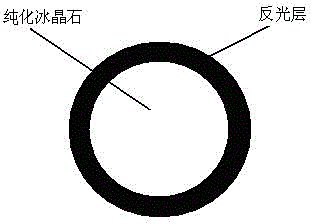Light-transmitting inorganic light diffusion agent and preparation method thereof
A light-diffusing agent and inorganic technology, applied in the field of light-diffusing materials, can solve the problems of inorganic light-diffusing agents being opaque, and achieve the effects of high sphericity, good haze, and good flow dispersion
- Summary
- Abstract
- Description
- Claims
- Application Information
AI Technical Summary
Problems solved by technology
Method used
Image
Examples
Embodiment 1
[0035] 1) Purify 85% cryolite by calcining at 700-800°C for 0.5 hours, then mix it with lye to make a slurry, perform high-speed ball milling on the slurry for 1 hour, wash with water until neutral, filter, and dry for backup use;
[0036] 2) Melt 8% pyrophyllite, 5% kaolin, 1% potassium feldspar, and 1% brucite at a temperature of 1200°C, then pulverize and grind to obtain a fine powder with a fineness of 3000-6000 mesh;
[0037] 3) Mix the fine powder obtained in step 2) with deionized water to make a slurry. In the fluidized bed, distribute the purified cryolite powder obtained in step 1) on the vibrating plate. While vibrating, the slurry is blown by the airflow It enters the bed from the lower part, and as the air velocity increases, the cryolite powder on the vibrating plate boils, is covered by the slurry, and dried at a drying temperature of 80-90°C;
[0038]4) Calcinate the dry coating material obtained in step 3) in a dynamic powder calciner at 800-950°C for 2 hours...
Embodiment 2
[0041] 1) Purify 88% cryolite by calcining at 700-800°C for 1 hour, and then mix it with lye to make a slurry. The slurry is subjected to high-speed ball milling for 1.5 hours, washed with water until neutral, filtered, and dried for backup use;
[0042] 2) Melting 6% pyrophyllite, 5% kaolin, 0.5% potassium feldspar, and 0.5% brucite at a temperature of 1300°C, then crushing and grinding to obtain a fine powder with a fineness of 3000-6000 mesh;
[0043] 3) Mix the fine powder obtained in step 2) with deionized water to make a slurry. In the fluidized bed, distribute the purified cryolite powder obtained in step 1) on the vibrating plate. While vibrating, the slurry is blown by the airflow It enters the bed from the lower part, and as the air velocity increases, the cryolite powder on the vibrating plate boils, is covered by the slurry, and dried at a drying temperature of 80-90°C;
[0044] 4) Calcinate the dry coating material obtained in step 3) in a dynamic powder calciner...
Embodiment 3
[0047] 1) Purify 90% cryolite by calcining at 700-800°C for 0.8 hours, and then mix it with lye to make a slurry. The slurry is subjected to high-speed ball milling for 1.5 hours, washed with water until neutral, filtered, and dried for backup use;
[0048] 2) Melting 5% pyrophyllite, 3% kaolin, 1% potassium feldspar, and 1% brucite at a temperature of 1200°C to 1300°C, and then crushing and grinding to obtain a fineness of 3000-6000 mesh pink;
[0049] 3) Mix the fine powder obtained in step 2) with deionized water to make a slurry. In the fluidized bed, distribute the purified cryolite powder obtained in step 1) on the vibrating plate. While vibrating, the slurry is blown by the airflow It enters the bed from the lower part, and as the air velocity increases, the cryolite powder on the vibrating plate boils, is covered by the slurry, and dried at a drying temperature of 80-90°C;
[0050] 4) Calcinate the dry coating material obtained in step 3) in a dynamic powder calciner...
PUM
| Property | Measurement | Unit |
|---|---|---|
| Particle size | aaaaa | aaaaa |
| Fineness | aaaaa | aaaaa |
| The average particle size | aaaaa | aaaaa |
Abstract
Description
Claims
Application Information
 Login to View More
Login to View More - R&D
- Intellectual Property
- Life Sciences
- Materials
- Tech Scout
- Unparalleled Data Quality
- Higher Quality Content
- 60% Fewer Hallucinations
Browse by: Latest US Patents, China's latest patents, Technical Efficacy Thesaurus, Application Domain, Technology Topic, Popular Technical Reports.
© 2025 PatSnap. All rights reserved.Legal|Privacy policy|Modern Slavery Act Transparency Statement|Sitemap|About US| Contact US: help@patsnap.com

